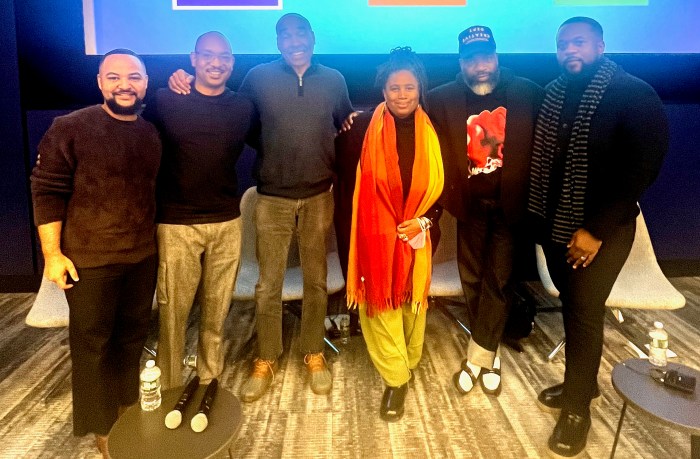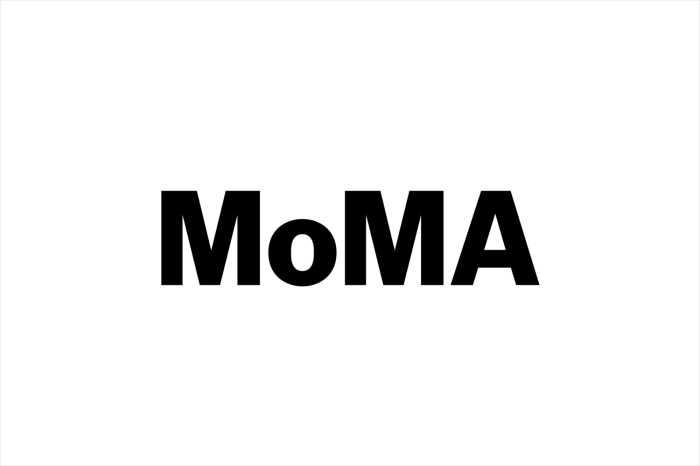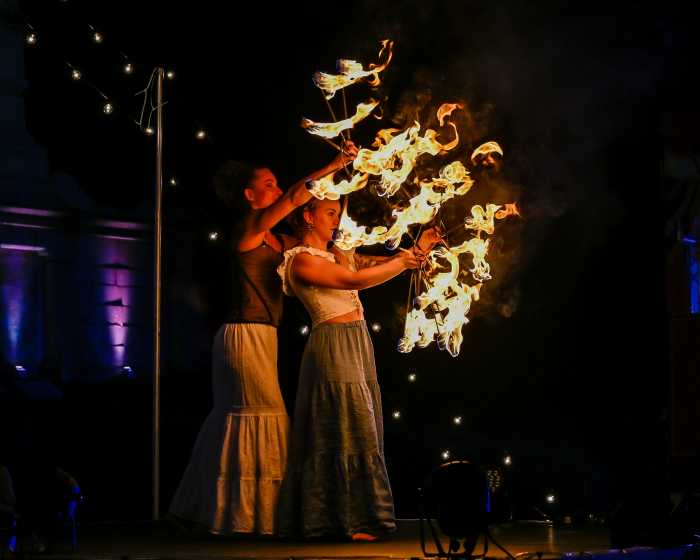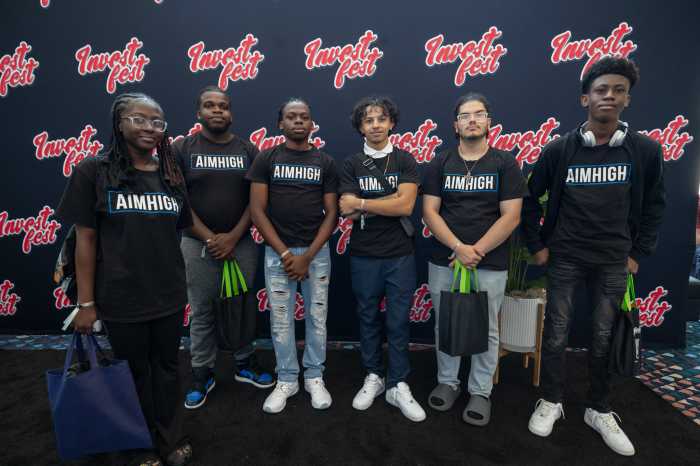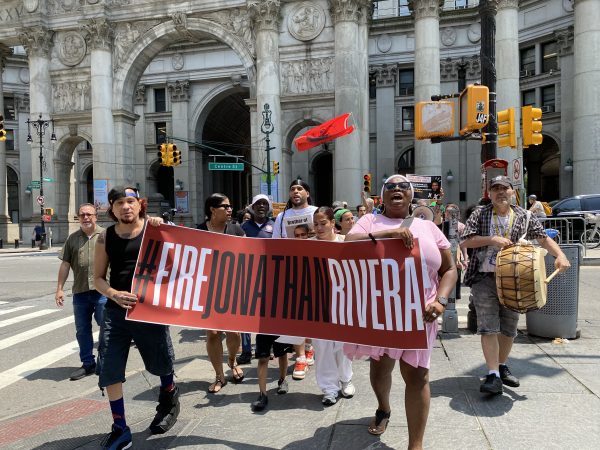A close up of Henry Darger’s “Untitled / Untitled” (double-sided), c. 1950–1960; watercolor, pencil, carbon tracing, and collage on pieced paper.
| AMERICAN FOLK ART MUSEUM, NEW YORK
Alot of people have a hard time with the American Folk Art Museum at 2 Lincoln Square near the Mormon Temple and a short walk from the glories of Lincoln Center. When they see the word “folk art,” they think quilts, decoys, weather vanes, and other bits of Americana they can live without. This is not your grandma’s folk art museum — although it does have quilts, decoys, and weather vanes in its collection of 7,000 items.
In truth, the American Folk Art Museum is a repository of brilliant, gorgeous, almost blinding stuff ranging far beyond the usual folk canon into what is referred to as “outsider” or “self-taught” art. The only limit it has is the sheer talent — even genus — of this work. Its great glory is its huge Henry Darger (1892-1973) holding of about 160 separate works by this reclusive Chicago janitor sometimes referred to as the “American Van Gogh,” but there is an array of other important work, too. Intensely visionary art, the art of crazy geniuses and queer seers, and science fiction imaginings the way they used to be, filled with hand-painted dreams and hallucinations, not computer-driven images, although some of the work in the museum foresaw computers by half a century, converted by these very spun-out minds into their own unique visual languages.
“Vestiges and Verses” celebrates art’s narrative meanings
The name of the current big show at the Museum is “Vestiges and Verses: Notes from the Newfangled Epic.” I asked Valérie Rousseau, curator of the show and of Self-Taught and Art Brut at the museum, what “Newfangled Epic” meant.
“It’s a life-long narrative, with egos and alter-egos; they have the styles and profiles of epics. We have a sensibility today that can relate to this art, with symbols, emojis, and a depth of content linking images—”
“Like hieroglyphics?” I suggested.
She agreed: “Yes, like hieroglyphics. You see patterns in these works, you see narrative structures in them.”
As a writer, I wanted to dive right in, since the narrative aspect of art, rejected for decades in favor of pure formal or structural aspects, is important to me. For many critics in the past, formality was everything because if you actually looked at what the artist was saying, it was too “queer,” too threatening, to be acknowledged. Instead you avoided it, and just went “Oooh!” and “Ahhh!” over the arrangements of colors or lines.
You don’t do that in this show. You want to know what these artists are saying: What do all these strange but wondrous images mean?
Curator Valérie Rousseau “The Living Klein Bottle House of Time” by Paul Laffoley (1935-2015).| COLLECTION OF | NORMAN AND EVE DOLPH
For many people, Darger, whose work has become extremely popular, almost obsessional, will be a point of entrance into this kind of art. I myself went through a Darger obsession when I was almost in love with his work. Like many fans, I wanted to be suffused with his colors, patterns, and images, his extreme naiveté verging on a queer saintliness, all those little girls with penises and horns, the radiantly innocent boys out of your deepest childhood dreams, and those menacing adults out of nightmares.
“The Newfangled Epic” presents 22 Darger objects and paintings, including one of those rare showings of his great epic (full title) “The Story of the Vivian Girls in What Is Known as the Realms of the Unreal, of the Glandeco-Angelinian War Storm Caused by the Child Slave Rebellion,” usually shortened to “The Realms of the Unreal.” At close to 2,000 typed pages, it may be the world’s longest piece of fiction, with an ending that says, “to be continued.” It is pure, direct-from-the-brain stream-of-consciousness with no real plot or character development. Darger’s paintings are often seen as illustrations of “The Realms,” but in truth they are not. They are more like condensed stories on one page; they came later than the novel that he began in 1910, and Darger, who was very influenced by movies and print comics, used his intense, often disturbing paintings more as cinematic narratives frozen in place.
In Darger’s work, as in the work of almost all outsider artists, there is no sense of hierarchy, of focal point or narrative climax. Instead, things are seen as a vast plain of information that can be entered from any direction. What is important is to understand, or accept, a series of clues, codes, and languages, which become a condensation of the past and the future together. So time, in a very druggy way, becomes flattened. In “The Newfangled Epic,” art and reality expand infinitely, so that what you are seeing on the walls, and in the work of the 21 artists presented here, is merely a “crop” or cropping of this far-extending reality, an immediate slice of it. Each cropping, or piece of art, encompasses a field of experiences, ideas, and beliefs.
The artists represent a range of periods and origins. Some are Spanish, German, Canadian, French, and American. Some were born in the late 19th century, others in the mid-20th century and are alive today. Some, like Malcolm McKesson (1909-1999) whose work both visually and in his own epic — a novella called “Matriarchy: Freedom in Bondage” — centers on children, female dominance, and male cross-dressing, are transgressive and reside easily within the often secretive shadow of the queer umbrella. As they used to say back in the 1960s and ‘70s, this is a place to get your mind blown, and you can do it for free: there is no admission charge at the American Museum of Folk Art, only a short block or two from Lincoln Center.
VESTIGES AND VERSES: NOTES FROM THE NEWFANGLED EPIC | American Folk Art Museum, 2 Lincoln Square, 66th St. at Columbus Ave. | Through May 27: Tue-Thu. & Sat., 11:30-7 p.m.; Fri., noon-7:30 p.m.; Sun., noon- 6 p.m. | Free admission | folkartmuseum.org or 212-595-9533



